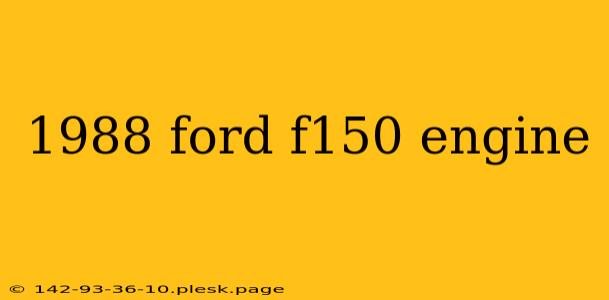The 1988 Ford F-150, a classic American truck, boasted a range of powerful engines, each with its own strengths and weaknesses. Understanding these engines is crucial for owners, enthusiasts, and anyone considering purchasing a vintage F-150. This guide delves into the specifics of the powerplants found under the hood of the '88 F-150, offering insights into their performance, reliability, and common issues.
Engine Options for the 1988 Ford F-150
The 1988 model year offered several engine choices, catering to various needs and preferences. The most common options included:
1. 4.9L (300 CID) Inline-6: The Workhorse
This venerable inline-six engine was a staple in Ford trucks for decades. Known for its durability and reliability, the 4.9L was a favorite among those who valued longevity and straightforward mechanics. Its torque-heavy nature made it ideal for towing and hauling, even if it lacked the high-revving power of V8 options.
Pros:
- Exceptional durability and longevity: Many examples are still running strong today.
- High torque: Excellent for towing and hauling.
- Simple design: Relatively easy to maintain and repair.
- Fuel-efficient (relatively): More fuel-efficient than the larger V8 options.
Cons:
- Lower horsepower: Less powerful than V8 counterparts.
- Can be sluggish: Acceleration might feel slow compared to modern engines.
2. 5.0L (302 CID) V8: The Popular Choice
The 5.0L V8 was a popular choice for its balance of power and relatively good fuel economy for a V8 of its time. It offered a significant performance boost over the inline-six, making it appealing to those who wanted a more spirited driving experience.
Pros:
- More horsepower and torque than the inline-six: Better acceleration and towing capacity.
- Smooth operation: A refined V8 experience compared to the inline-six.
- Relatively good fuel economy for a V8: Acceptable fuel consumption for its power output.
Cons:
- More complex than the inline-six: Maintenance and repairs can be more involved.
- Potential for issues: Like any engine, it's susceptible to problems like valve train issues or carburetor problems (depending on the specific configuration).
3. 5.8L (351 CID) V8: The Muscle
For those needing maximum power, the 5.8L V8 was the top-of-the-line option. This large-displacement V8 delivered considerable horsepower and torque, making it a favorite for heavy-duty applications and towing large loads. However, this power came at the cost of fuel efficiency.
Pros:
- Exceptional power and torque: Best for heavy towing and hauling.
Cons:
- Poor fuel economy: Significantly lower fuel mileage compared to other options.
- Higher maintenance costs: Larger engine means potentially higher maintenance costs.
Common Issues and Maintenance
Regardless of the engine chosen, regular maintenance is crucial for prolonging the life of any 1988 Ford F-150 engine. Common issues across all engines can include:
- Carburetor problems (if equipped): Regular cleaning and maintenance are essential.
- Ignition system issues: Worn spark plugs, wires, or distributor cap can cause performance problems.
- Cooling system issues: Leaks, failing water pump, or thermostat problems are common.
- Exhaust system issues: Rust and leaks are common in older vehicles.
By addressing these potential issues proactively and performing regular maintenance, owners can ensure their 1988 Ford F-150 engine remains reliable and powerful for years to come. Consult a repair manual specific to your engine for detailed maintenance schedules and procedures.
This guide provides a general overview; specific engine performance and reliability can vary depending on individual vehicle condition and maintenance history. Always consult a qualified mechanic for diagnosis and repair of any engine issues.

